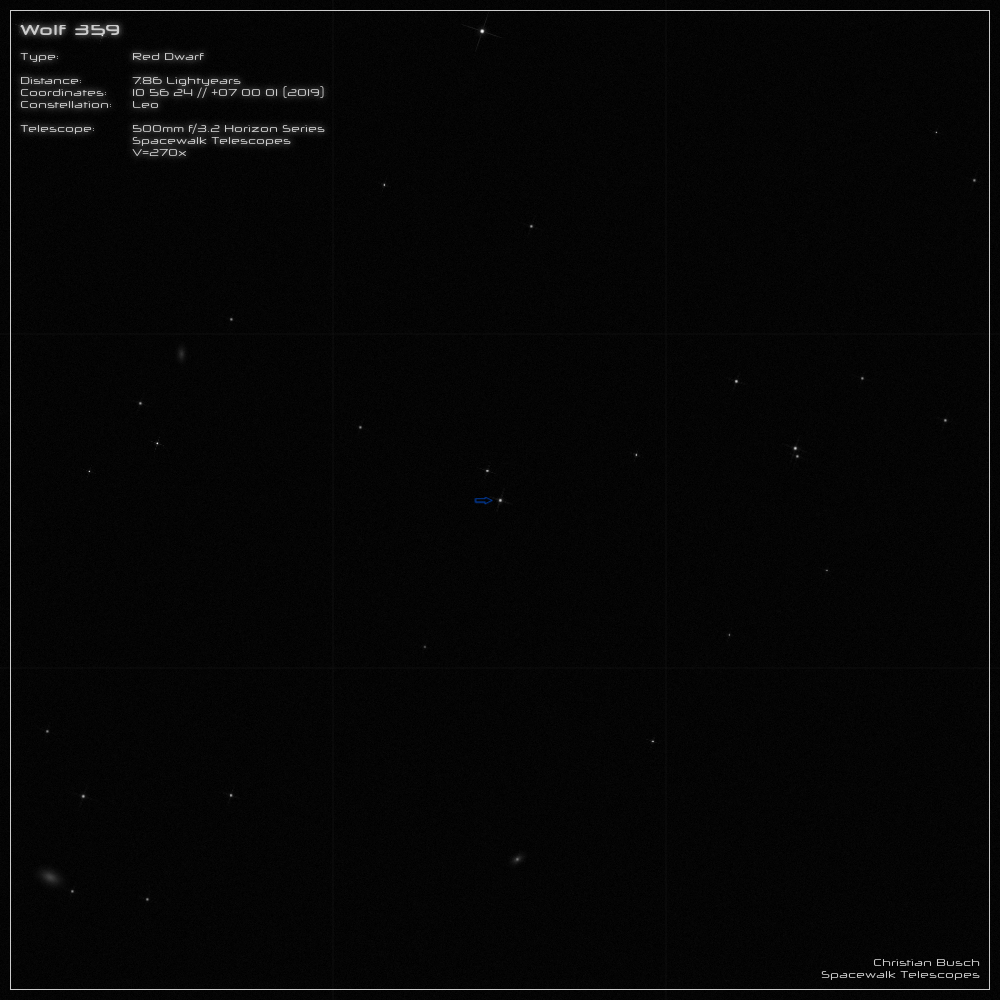Wolf 359: A special star - not only for Stark Trek fans!
Star Trek fans surely know the star "Wolf 359" from a particularly exciting episode of TNG, when the Borg set off with their cube towards Earth to destroy it.
Out there, 8 light years away from Earth, a fierce space battle was raging, the outcome of which shall not be revealed here.
Even if all this is only science fiction, it is obvious to see this special star with your own eyes. But that's not as easy as you might think. Despite the short distance
Wolf 359 shines only with an apparent brightness of 13.5mag in the sky. So you need a telescope with at least 10" aperture to see the star reasonably. Since the
distance to "Wolf 359" is known very precisely, also the absolute brightness can be determined very accurately. It is in the visual spectral range about 1/50,000
of the sun's luminosity. Even at a distance of only one light year the red dwarf star would be just 9mag bright. Despite its low luminosity, the red dwarf star
generates its energy at the center by fusion of hydrogen. However, the energy is conducted outward by convening currents, so that the stellar matter is constantly
mixed. This allows the star to generate energy over a period of 8 trillion years, making it shine 1000 times longer than our Sun. The surface temperature is just
over 2,500°C, which is very little for a star. Accordingly it belongs to the spectral class M6.5. Its diameter can be calculated to about 250,000 kilometers, so it is
not even twice as big as the planet Jupiter.
Wolf 359 is orbited by two planets, of which the inner one belongs to the class of "super earths" and needs just 3 days for one orbit. The outer planet, on the other
hand, is about as large and massive as Neptune and orbits its central star once every 8 years.
----------------------------------------------------------------------------------------------------------------------------------------------
The observation of "Wolf 359" in my 50cm telescope was well feasible thanks to the large aperture.
The position was found quickly with an accurate finding card. Due to the large proper motion one should take care to have a current position available, because in
the near vicinity there are some stars in question, which could be mistaken for "Wolf 359".
With a magnification of 270x the red dwarf star was clearly visible with indirect vision. It always seems to me that very red stars are more difficult to see than
visually equally bright stars of a different spectral class. But maybe this is just imagination... During the preparation I had noted some faint galaxies, which can be
found near Wolf 359. The brightest is UGC 6046, which appeared as a slightly oval spot of light with a brighter central area and was not that difficult with indirect
vision under the dark sky. The other two galaxies are much fainter and thus not as easy to see. But with indirect vision they flashed out of the darkness every now
and then.
Even if "Wolf 359" is only a very faint star, it was a great observation for me as a Startrek fan, even if the debris of the space battle was not visible. ;)

